
[C462_17.jpg]
The 80mm standard lenses in Exakta 66 style
Remarkably, four different 80mm lenses were offered for the Exakta 66 (1984-2000 model).

[C462_17.jpg]
| Xenotar MF or
E? There were two types of Schneider Xenotar in Exakta 66 mount: the original lens, which is designated “MF” in the literature and on the lens ring, and a newer, cheaper lens, designated “Xenotar E”. See details of the “Xenotar E” below. The Schneider Xenotar MF was manufactured by Schneider-Kreuznach for a range of leading camera manufacturers, including Rollei, and is considered is one of the world’s top standard lenses for medium format. Many consider it superior to the Planar made by Carl Zeiss (Oberkochen, former West Germany) for the Hasselblad. Who made the
80mm Biometar lens in Exakta 66 style?
I am also grateful to Donggil Lee of Seoul, South Korea for drawing my attention to the fact that the colours of the Multi Coating on this version of the Biometar “are more like those of M42 Carl Zeiss Jena lenses than those of Schneider lenses including Schneider Exakta 80mm lens and Xenotar 80mm lens”. I have checked with my examples of these lenses, and can confirm these differences: the Xenotar MF and Exakta 80mm lenses have a deeper purple in the multi-coating, while the Biometar has a lighter, pinker colour, although this is not at all like the amber colour multi-coating on the 80mm MC Biometar that came with one of my Pentacon Sixes (unequivocally from East Germany) in the mid 1980s. However, later East German Biometars had a different, light purple multi-coating. There is another interesting fact that does seem to point
conclusively to this lens not having been
manufactured by Joseph Schneider: the serial number.
In January 2006 I came across a database of serial numbers
for Joseph Schneider lenses. It can be seen at http://www.schneiderkreuznach.com/service/serie.htm,
part of Schneider Kreuznach’s own website, and therefore
presumably authoritative. But my Biometar in Exakta 66 style has a five digit
serial number beginning with 48 – i.e., it is in
the 48 thousands. Hartmut Thiele’s excellent
reference work “Fabrikationsbuch Photooptik II Carl Zeiss
Jena” is an authoritative source on Carl Zeiss Jena serial
numbers, and it shows that in the last months of the GDR
Carl Zeiss Jena manufactured 6,000 80mm Biometar lenses –
naturally in the standard Pentacon Six style – and the
serial numbers ran from 42001 to 48000. These lenses
were made using the newer, 1979, lens
re-calculation. They were completed on 29th
March 1989. I originally believed that these
were the last 80mm Biometars that were produced in the
Pentacon Six style.
By the time the Biometar lenses in Exakta 66 style were
being manufactured, all sorts of deals were being done
between former East German and West German companies, with
Carl Zeiss Oberkochen (former West Germany) buying
parts – but not all! – of Carl Zeiss Jena, and
Schneider Kreuznach linking up with at least parts of
Pentacon.
This version of the lens is physically much larger than the original Biometar, with the front extending much further forward and out, to accommodate the standard-size 67mm filter that fits many of the Exakta 66 lenses. Some users report that in consequence of this, a lens hood (“shade”) is not really necessary with this lens. To see earlier versions of the 80mm Biometar in Praktisix/Pentacon Six mount, click here. Xenotar E
Some claim that this may have been a re-labelled Biometar manufactured by Schneider. However, serial number evidence indicates that these lenses were almost certainly part of the same batch as the Biometars in Exakta 66 style. Perhaps the only thing changed was the name ring on the front of the lens, a trick that Carl Zeiss Jena were experienced in using, in order to export to certain countries where they were not allowed to use the Carl Zeiss name. One thing, however, is different: the multi-coating (see below). “Exakta” 80mm
lens |
Comparison of the 80mm standard lenses in Exakta 66 style

[C462_16.jpg]
Left to right: Xenotar MF, Biometar, Xenotar E, Exakta
Here is a summary of the similarities and differences between
these four lenses.
| Name on lens ring: | Schneider-Kreuznach Xenotar MF | Carl Zeiss Jena Biometar | Schneider-Kreuznach Xenotar E | Exakta |
| Minimum focussing distance m: | 0.6 | 1.0 | 1.0 | 0.95 |
| Dimensions (dia × length) mm: | 84 × 72 | 82 × 68 | As Biometar | 83 × 74 |
| Weight g: | 500 | 440 | As Biometar | 450 |
| Location of rear-most element: | Deeply recessed | Protruding from rear surface | As Biometar | As Biometar |
| Rear element retaining ring: | Deeply recessed | Protruding above rear surface. Scalloped on top edge to allow mirror to pass (as on Biometars for the Pentacon Six) | As Biometar | As Biometar |
| Pin heads visible on rear surface: | Two black pins | Three “silver” pins (as on Biometars for the Pentacon Six, in which, however, one of the pins is black) | As Biometar | As Biometar |
| Stop-down lever: | Wide sliding black bar under lens – as on other Schneider lenses for the Exakta 66 | Tiny “silver” lever at approximately “7.00 o’clock” (as on Biometars for the Pentacon Six) | As Biometar | As Biometar |
| Raised lettering on front surface of rubber focussing ring: | SCHNEIDER-KREUZNACH MADE IN GERMANY |
EXAKTA 66 MADE IN GERMANY |
As Biometar | As Biometar |
| Multi-coating name: | MULTICOATING S | MULTICOATING | As Xenotar MF | As Biometar |
| Multi-coating colour: | Slightly less deep purple than “EXAKTA” lens | Lighter than “EXAKTA” & “XENOTAR MF”, almost pink | Totally different from the other three – a light amber-yellowish colour | Deep purple reflections |
| Serial number range: | 14 millions | 48 thousands | As Biometar | 14 millions |

[C462_20.jpg]
Left to right: Xenotar MF, Biometar, Xenotar E, Exakta, plus, to
the right of them, the CZJ Biometar in Pentacon Six styling
Note that when the Biometar was made in Exakta 66 styling, it
was necessary to reverse the direction of the aperture ring,
to enable it to input the correct values into the Exakta 66
metering prism

[C462_19.jpg]
Rear view (lenses arranged in the same order)
Note the differences between the Xenotar MF, on the left and all
other four lenses, as regards pin and screw positions, shape of
stop-down lever, etc.

[C462_21.jpg]
Note shape of the rear element retaining ring, scalloped at the
top on the all lenses other than the Xenotar MF to allow
clearance for the mirror.
It is also clear in this image that the rear element of the
Xenotar MF is recessed within the mount.
Summary of Multi-coating differences
All four 80mm lenses are different from each other.
The “EXAKTA” lens has the deepest purple reflections.
The “XENOTAR MF” has slightly less deep purple reflections.
The BIOMETAR has lighter-still reflections, almost pink.
The “XENOTAR E” has a totally different colour from the other
three – a light amber-yellowish colour similar to but deeper than
that seen on some East German Carl Zeiss Jena lenses for 35mm
cameras.
The aperture blades of all four of these lenses have a
virtually-identical matt-black finish, quite unlike the shiny
black surface of the aperture blades on the Biometars built by
Carl Zeiss Jena in GDR times. It is clear that after the
fall of the Berlin Wall and the collapse of communism in East
Germany in November 1989, there was considerable exchange of
technical expertise (and possibly of some parts?) between the
Schneider-Kreuznach and Carl Zeiss Jena. It is also possible
that components may have been sourced from more than one
manufacturer, for instance, the lens elements in Jena and the
barrels (and assembly?) in Bad Kreuznach.
| Reconstructing
History
FACT: The Exakta 66 was launched
in 1984 with the Schneider-Kreuznach Xenotar MF as the
only standard lens available. This outstanding
lens had a high price, which was reflected in the
Exakta 66 outfit price. The rest of this box is SURMISE. The aim was obviously to boost the sales of the whole Exakta 66 system. I surmise that offering the
Carl Zeiss Jena Biometar did not achieve this aim, and
that Exakta GmbH decided to avoid buyer resistance to
buying an “East German” lens by relabelling the
Biometar “Xenotar”. I surmise that:
I therefore surmise that Schneider-Kreuznach either decided to or had to manufacture the lens themselves. This new version of the lens was given the name “EXAKTA”, but was in fact still optically the original Biometar lens. |
New information, January 2010
The above section was written in March 2009. I have just (January 2010) obtained a copy of the lens diagrams for the “Biometar” and “Exakta” lenses in the Exakta 66 livery. They were contained in a catalogue of photographic items distributed in Germany by the firm Beroflex. This catalogue was produced for their own company reps only, not for public distribution, and included details of Praktica cameras and lenses and other ranges distributed by Beroflex, including the Exakta 66. The catalogue is dated March 1992 – after the re-unification of the two Germanies and at a time when the Exakta 66 was still being marketed. In the latest endeavour to boost sales of the Exakta 66, the “Exakta” 80mm lens had been introduced. Here is a section from one of the pages:
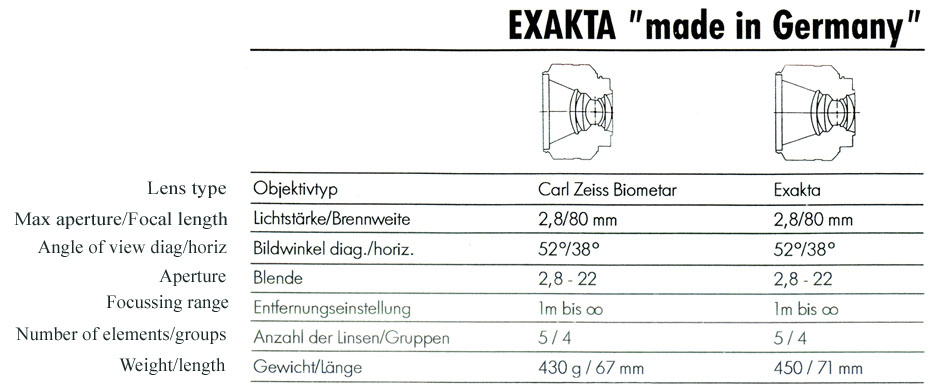
I have added on the left an English translation
of the title for each line. It is clear that the data is
the same for both lenses, except for the two points referred to
above: the front of the “Exakta” lens has been made
longer/deeper, and this has naturally increased the weight
slightly.
| Here are the lens diagrams only, in a
larger size to make them easier to compare:
I have added grey to the lens elements, to make them easier to distinguish from the lens body. It is clear that optically this is the original Biometar 5-element design as supplied for the Pentacon Six. The company reps were presumably given this information to enable them to decide how much detail to share with retailers, when promoting the Exakta 66 system. |
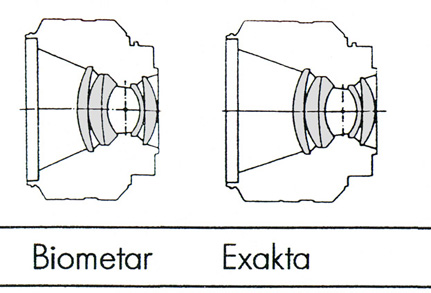 |
Conclusive
evidence
Having used the barrel of an 80mm “Exakta” lens for the mounting of the 40mm Schneider Curtagon (details here), I had a spare set of “Exakta” elements. Then I came across an 80mm Biometar lens in “zebra” style, in excellent condition apart from scratches to the front element and dirt between the elements. I asked Tom Page if he could mount the “Exakta” elements in the Biometar mount. They fitted perfectly! In fact, one can see that they are of the same design. |
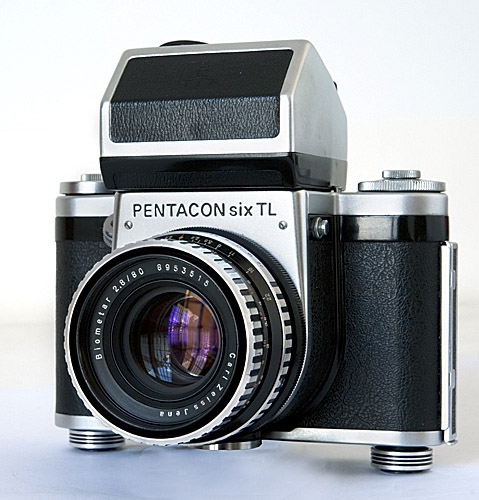 This “zebra” Biometar now has multi-coated elements, whereas all the Carl Zeiss Jena zebra lenses had single coating only. |
| I am grateful to Rick Denney
for drawing my attention to the fact that this is the
same as the original formulation of the
Schneider-Kreuznach Xenotar, as patented in various
countries in 1952 and used in the Rolleiflex and other
medium format cameras.
The original formulation of the Schneider-Kreuznach Xenotar had five elements. Later versions of the Xenotar had six or seven elements. The Xenotar MF as supplied for the Exakta 66 and various other Medium Format SLRs in the 1980s had 7 elements in 6 groups. Now it would be good to see the lens diagram for the “Xenotar E”! It might be reasonable to guess that it will be the original 5-element design – in other words, equivalent to the Biometar or the “Exakta” whose design is shown above. Rudolf Kingslake states in “A History of the Photographic Lens” that this original formulation of the Schneider Xenotar is the same as the (West) German Zeiss Planar that was produced after World War II. |
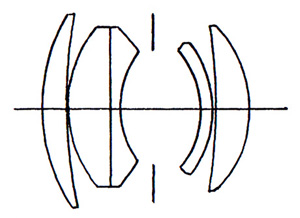 The original formulation of the Schneider-Kreuznach Xenotar (c. 1952). |
| However, this drawing that
is reported as being of the original 5-element Carl
Zeiss (West Germany) Planar lens as installed in the
Rolleiflex Twin-Lens Reflex in the early 1950s shows a
different configuration of the front three elements.
As with the Schneider Xenotar, subsequent designs of the Zeiss Planar had six elements, and then seven elements. (The Rolleiflex TLR was available with a choice of taking lens.) |
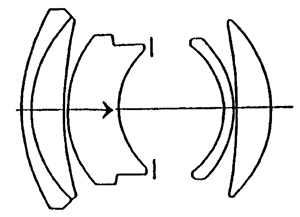 From “A lens collector’s Vademecum” |
To return to the page on Schneider lens data, click here.
To return to the lens tests of 80mm lenses, click here.
To go on to the next section, click below.
Next section (Arsat Lenses)
To go back to the beginning of the Lens Data section, click below
and then choose the range of lenses that you want to read about.
Back to beginning of the Lens Data section
© TRA March 2009. Latest revision: August 2017